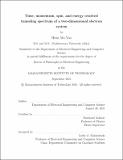Time, momentum, spin, and energy resolved tunneling spectrum of a two-dimensional electron system
Author(s)
Yoo, Heun Mo
DownloadThesis PDF (22.18Mb)
Advisor
Ashoori, Raymond
Terms of use
Metadata
Show full item recordAbstract
Two-dimensional (2D) electronic systems host a plethora of remarkable phenomena, including the integer and fractional quantum Hall effects (Nobel Prize 1985 and 1998), and have stimulated a wide range of fundamental science and engineering research. Yet, many of the important phenomena that emerge from the collective behavior of 2D electrons remain poorly understood as there have been substantial experimental challenges in probing the electronic structures and interactions in these systems. In this thesis, we present a time-domain pulsed tunneling technique that can visualize the energy, momentum, spin, and time resolved electronic structures of 2D electronic systems. Unlike the conventional tunneling method that requires the in-plane conductivity of the system, our pulsed tunneling technique functions on strongly insulating systems at low temperatures or in large applied magnetic fields. Furthermore, through the use of pulses that drive tunneling in extremely short time intervals, the technique eliminates perturbations such as heating. Using the pulsed tunneling technique, we visualized the effect of electron-optic phonon interactions and Landau level quantization in energy-momentum space. We also performed spin resolved pulsed tunneling experiments and measured the magnetization of a 2D electronic system over a wide range of applied magnetic fields and electron densities. Moreover, we pumped a 2D electronic system using an additional electrical pulse and imaged time resolved tunneling spectra of the system driven out of equilibrium. These results illustrate the potentially broad applicability of our time-domain pulsed tunneling technique to studying correlated electron phenomena in a wide variety of emerging two-dimensional materials.
Date issued
2021-09Department
Massachusetts Institute of Technology. Department of Electrical Engineering and Computer SciencePublisher
Massachusetts Institute of Technology